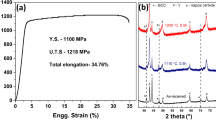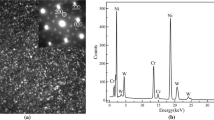Abstract
Early studies showed that the two-phase ordered alloy of semi-coherent β–Ni2AlTi (L21) and β–Ni(Al, Ti) (B2) exhibits excellent elevated-temperature creep strength, and the precipitation of the “rod-like” γ’–Ni3(Al, Ti) (L12) from either the β or the β’ phase improves the room-temperature ductility of the phases concerned. In the present investigation an attempt is being made to combine the above microstructural features in β’–β–γ’ three-phase alloys and for this purpose the composition Ni63Al22Ti15, near the β’–γ’ edge of the three-phase region in the recently estimated Ni–Al–Ti isotherm at 900 °C, has been selected for detailed study. The expected precipitation of both the β and the γ’ phases occurs in the dendritically solidified β’ phase after a 1100 °C/3 h homogenization and a 900 °C/115 h anneal, although the original interdendritic γ’ phase remains. The morphology of the two types of precipitates and their orientation relationships with the β’ parent phase have been examined using transmission electron microscopy and diffraction, and the experimentally obtained data compared with those predicted by Khachaturyan’s elastic strain energy theory. The β precipitates are nearly cuboidal in shape and are bounded by interface dislocations of aβ〈100〉 edge type. For the β precipitates, both morphology and orientation relation agree with those predicted by the theory. The γ’ precipitates were found to obey the Nishiyama–Wassermann orientation relationship with the parent phase. These precipitates are about 0.5 μm thick and elongated along their 〈211〉 directions, and in all cases consist of two twin-related variants, giving a sword-like morphology. The {i11} twin planes, parallel to the {1i0} of the parent phase, have been identified as the habits of the precipitation. The theory, however, predicts a habit of {0.732, 0, 0.681}γ’ type and a Baker–Nutting orientation relationship. This discrepancy has been attributed to the inapplicability of some assumptions made in the theory: equal elastic moduli between parent and product phases and a tetragonal transformation strain based on Bain’s model of the bcc → fcc transformation. The presence of diffuse streaks in the diffraction patterns of the parent phase, which can be correlated with the 〈110〉〈1i0〉 shear waves, suggests high elastic anisotropy and lends credit to Zener’s model. Crystallographic consideration shows that this model is feasible for the L21 → L12 transformation and explains the observed morphological features of the γ’ precipitates. Some earlier studies are also discussed.
Similar content being viewed by others
References
P. R. Strutt, R. S. Polvani, and J. C. Ingram, Metall. Trans. A 7A, 23 (1976).
R.S. Polvani, W-S. Tzeng, and P.R. Strutt, Metall. Trans. A 7A, 33 (1976).
J. D. Whittenberger, R. K. Viswanadham, S. K. Mannan, and K. S. Kumar, J. Mater. Res. 4, 1164 (1989).
R.W. Cahn, Metals Mater. & Processes 1, 1 (1989).
P. S. Khadkikar, K. Vedula, and B. S. Shabel, in High-Temperature Ordered Intermetallic Alloys, II, edited by N. S. Stoloff, C.C. Koch, C.T. Liu, and O. Izumi (Mater. Res. Soc. Symp. Proc. 81, Pittsburgh, PA, 1987), p. 157.
K. C. Russell and J.W. Edington, Metal. Sci. J. 6, 20 (1972).
R. Moskovic, J. Mater. Sci. 13, 1901 (1978).
S. R. Schuon, lecture presented at Symposium on Intermetallics, TMS-AIME, Phoenix, AZ, January 1988.
W. Bollmann, Phys. Status Solidi (a)21, 543 (1974).
R.C. Ecob and B. Ralph, Acta Metall. 29, 1037 (1981).
J.M. Rigsbee and H.I. Aaronson, Acta Metall. 27, 351 (1979).
D. A. Smith, K. M. Knowles, H. I. Aaronson, and W. A.T. Clark, in Solid-Solid Phase Transformation, Proc. Int. Conf., edited by H.I. Aaronson, D.E. Laughlin, R.E. Sekerka, and C.M. Wayman (Pittsburgh, PA, 1981), p. 587.
S. H. Wen, E. Kostlan, M. Hong, A. G. Khachaturyan, and J.W. Morris, Jr., Acta Metall. 29, 1247 (1981).
A. G. Khachaturyan, Theory of Structural Transformation in Solids (John Wiley & Sons, New York, 1983), Chaps. 7–12.
C. M. Wayman, in High-Temperature Ordered Intermetallic Alloys, edited by C.C. Koch, C.T. Liu, and N.S. Stoloff (Mater. Res. Soc. Symp. Proc. 39, Pittsburgh, PA, 1985), p. 76.
L. Delaey, A. J. Perkins, and T. B. Massalski, J. Mater. Sci. 7, 1197 (1972).
M. J. Kelly and W. M. Stobbs, Scripta Metall. 13, 919 (1979).
C Zener, Phys. Rev. 71, 846 (1947).
C Zener, Elasticity and Anelasticity of Metals (Univ. of Chicago Press, Chicago, IL, 1948), Chap. 4.
P. Nash, V. Vejins, and WW. Liang, Bull. Alloy Phase Diag. 3, 369 (1982).
P. Nash and W.W. Liang, Metall. Trans. A 16A, 319 (1985).
N. Saunders, private communication (1989); to be published.
K. Enami, J. Hasunuma, A. Nagasawa, and S. Nenno, Scripta Metall. 10, 879 (1976).
A. Lasalmonie, Scripta Metall. 11, 527 (1977).
F. Reynaud, Scripta Metall. 11, 765 (1977).
K. Enami, A. Nagasawa, and S. Nenno, Scripta Metall. 12, 223 (1978).
R. Portier, D. Gratias, and W. M. Stobbs, in Proc. ICOMAT 79 (MIT Press, Cambridge, MA, 1979), p. 541.
I. M. Robertson and C. M. Wayman, Philos. Mag. A 48, 421, 443, 629 (1983).
L.E. Tanner, D. Schryvers, and S.M. Shapiro, Mater. Sci. Eng. A127, 205 (1990).
I. M. Robertson and C. M. Wayman, Metallography17, 43 (1984).
S. Chakravorty and C. M. Wayman, Metall. Trans. A 7A, 555, 569 (1976).
Z. Nishiyama, Sci. Rep. Tohoku Univ. 23, 647 (1934).
G. Wassermann, Arch. Eisenhiittenwes. 16, 647 (1933).
W. J. Boettinger, L.A. Bendersky, F.S. Biancaniello, and J.W. Cahn, Mater. Sci. Eng. 98, 273 (1988).
L.A. Bendersky, P.W. Voorhees, W.J. Boettinger, and W. C. Johnson, Scripta Metall. 22, 1029 (1988).
R.D. Field, R. Darolia, and D.F. Lahrman, Scripta Metall. 23, 1469 (1989).
R. J. Wasilewski, Trans. TMS-AIME236, 455 (1966).
A. Ardell and R. B. Nicholson, Acta Metall. 14, 1295 (1966).
M. H. Yoo, in High-Temperature Ordered Intermetallic Alloys, II, edited by N. S. Stoloff, C. C. Koch, C.T. Liu, and O. Izumi (Mater. Res. Soc. Symp. Proc. 81, Pittsburgh, PA, 1987), p. 207.
P. Villars and L. D. Calvert, Pearson’s Handbook of Crystallo-graphic Data for Intermetallic Phases (ASM, Metals Park, OH, 1985), Vol. 2, pp. 1038, 1043.
N. Rusovic and H. Warlimont, Phys. Status Solidi44, 609 (1977).
P. Georgopoulos and J. B. Cohen, Scripta Metall. 11, 147 (1977).
R. Krachler, H. Ipser, and K. L. Komarek, J. Phys. Chem. Solids50, 1127 (1989).
Author information
Authors and Affiliations
Rights and permissions
About this article
Cite this article
Yang, R., Leake, J.A. & Cahn, R.W. A microstructural study of a Ni2AlTi–Ni(Al, Ti)–Ni3(Al, Ti) three-phase alloy. Journal of Materials Research 6, 343–354 (1991). https://doi.org/10.1557/JMR.1991.0343
Received:
Accepted:
Published:
Issue Date:
DOI: https://doi.org/10.1557/JMR.1991.0343




